
Two thousand high schoolers walk into MIT by CJ Q. '23
what could possibly go wrong?
I get it. There have been posts about Splash before. There have, in fact, been many posts about Splash before. Even Petey himself, the man, the legend, has taught for Splash. And this will be yet another post about Splash, because it was so awesome, so mindblowing, that going through the whole thing made me think, wow, I need to write about this.
I’ll begin with a disclaimer. The experience I talk about here is how I experienced Splash this year. For reasons I’ll talk about later in this post, this necessarily means that I can only capture a very small part of what the Splash experience is like.
This is a rather long post so here’s some contents:
- Part 1: Hi, are you interested in teaching for Splash?
- Part 2: Twelve hours of teaching
- Part 3: The why game
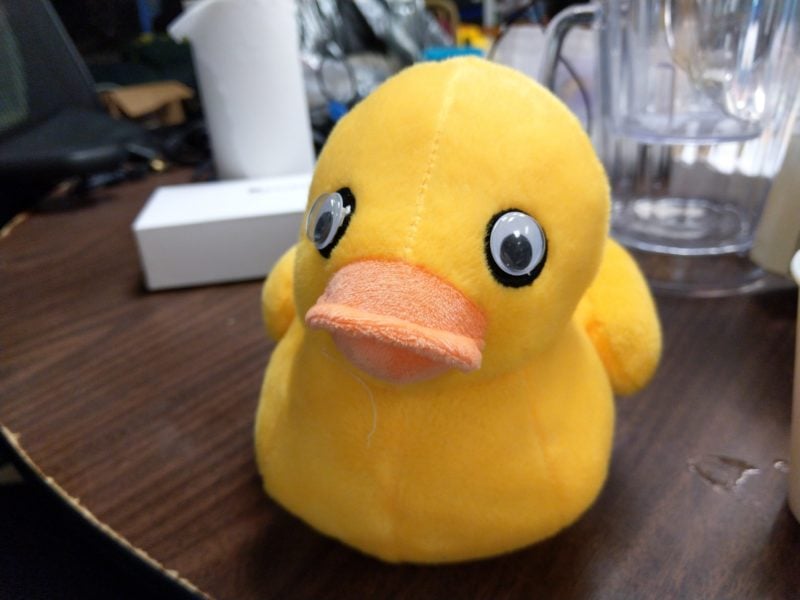
a duck i found in the esp office
Part 1: Hi, are you interested in teaching for Splash?
Learn anything
What’s Splash? It’s a weekend where high schoolers come to MIT and take classes about whatever they want. This year, Splash happened on November 23 and 24,01 so why is this post so late? I was busy, okay. the weekend before Thanksgiving. To me, the easiest way to explain Splash is to explain both its scale and the classes.
For one, Splash is huge. There were 2,142 students enrolled for Splash this year, and 608 teachers teaching 504 classes. And two thousand is a lot of people. For reference, the undergraduate population of MIT is only 4,602, of which 1,120 were first-years.
This means that there were nearly double the number of students than students in the Class of 2023. And throughout the weekend, these students had a presence in MIT’s hallways. In the same way that I spot a lot of my friends walking between classes, and I have way less than two thousand friends, all throughout the weekend there would be high school students all over campus. It’s huge. Huge.
The other really notable thing about Splash is its classes. The Educational Studies Program, the student group that runs Splash, has the motto “Learn anything, teach anything, do anything!” And the first time I looked at the class catalog, I truly felt how real that anything meant. Here are five random classes from that list:
- Intro to Trading, a crash course about how markets work.
- Your Body Is a Clock: Chronobiology. What even is chronobiology? I have no clue, but it sounds really cool, based on the description.
- this course has no content., the description of which is solely “look around you. what do you see? why is the world this way? who am i?” One of my friends, Colin T. ’23, taught the class, and when I talked to him after the program he said it went well.

- The Music of Celeste, an entire one-hour class dedicated to analyzing the soundtrack of the video game Celeste (which, by the way, is very good).
- Demystifying Cryptography, a class that planned to cover “secure hash functions”, “pseudorandom number generators”, and “the RSA cryptosystem” in the second half of a one-hour class. This one was also taught by some of my friends. Three of them, in fact. (I see you, Eric Z. ’23, Vincent H. ’23, and Hahn L. ’23.02 who is, in fact, from Harvard )
I remember the night I first heard about Splash, back in August. I was going through the course catalog of Splash 2018, and reading the descriptions of all of these cool classes, in absolute awe. There were so many wonderful, interesting things. Whatever I was interested in, there was a class about, and even things I didn’t know I was interested in. I wanted to learn about all of them. I wanted to take all of them!
Part of me wished that I was back in high school again, just so I could go to Splash and take classes. Some other part of me remembered how much better college is compared to high school, and quickly steered me towards a different course of action: going to Splash and teaching classes. If I couldn’t go to Splash and learn whatever I wanted, I could at least go to Splash and teach about whatever I wanted.
So it goes.
The extracurricular he really likes doing
I mentioned that the Educational Studies Program, ESP, is the student group that runs Splash. I remember my first encounter with ESP. The full story belongs for another time, but it was earlier this year in May. I was visiting MIT, and Andrew L. ’22, a freshman at the time, was gushing to me about how wonderful ESP was. He told me about all the great people he met working with them, and how much fun it was. No one bothered explaining to me, that night, what ESP was, other than it’s the extracurricular Andrew really likes doing.
My second encounter with ESP was through Firestorm, an event that happened last September. Firestorm’s tagline was “n classes in 5n minutes”, and it’s an evening where ESP admins03 people who make ESP stuff happen teach five-minute classes on anything in this large lecture hall.
The night begins with Brian C. ’19 giving a class called “How to make a timer for Firestorm”, in which he makes a five-minute timer in five minutes. This was followed by a whirlwind of classes which included “How to find free food”, “How to throw stuff away, the right way”, “Random airport facts”, and “All the two-letter Scrabble words”. There were also pool noodles, which were used to (gently) hit people who go overtime.
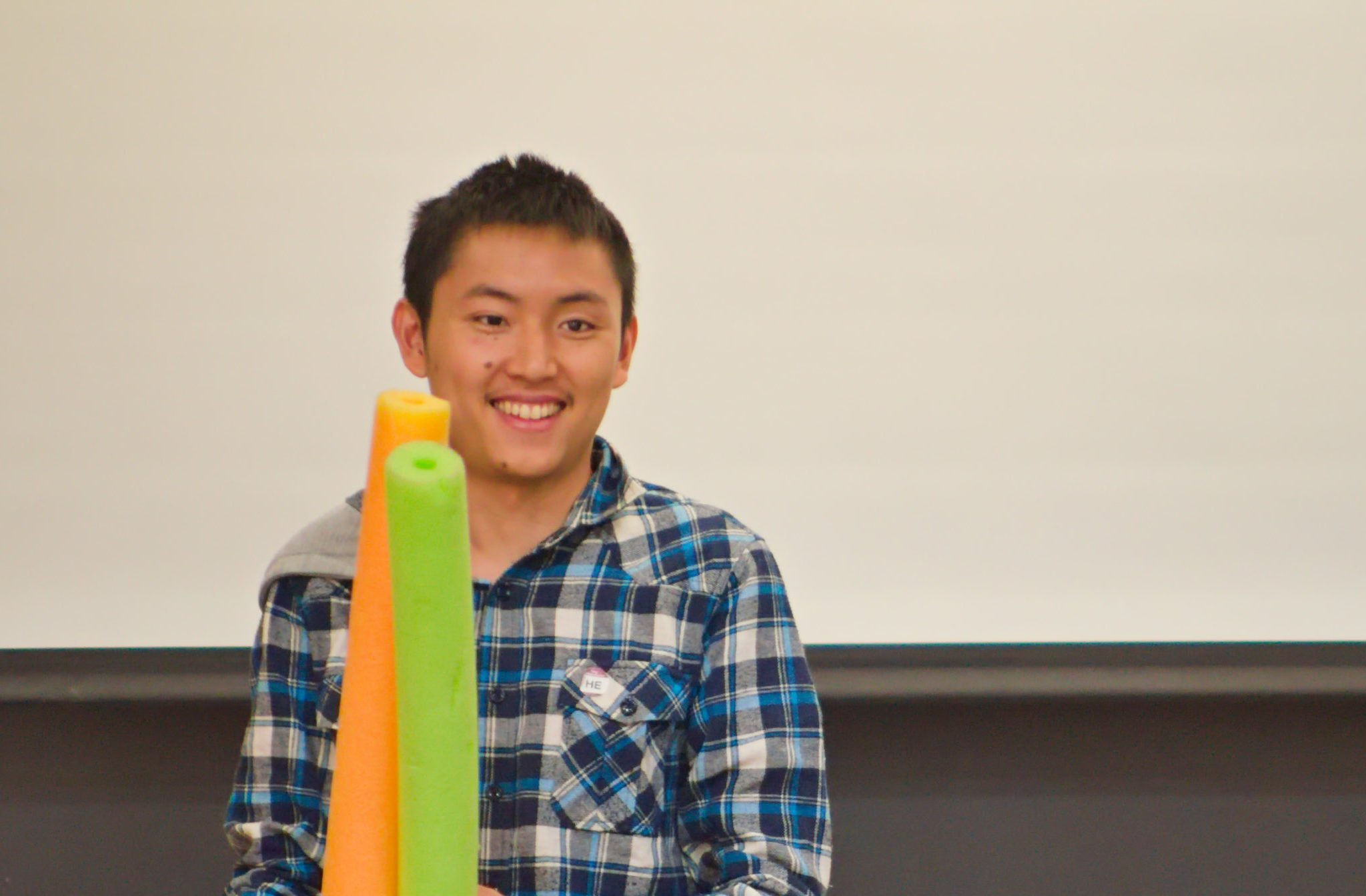
this is brian c. ’19, holding pool noodles. this wasn’t from firestorm, but a similar event called firehose that happens in cpw, which is like firestorm but it happens in cpw. photo: byron x. ’21
The event convinced me that ESP was pretty cool and I decided to show up to their worksessions. Let me explain what worksessions are. ESP has two regular weekly things at the ESP office. There are meetings on Tuesday evenings, where people talk… about… stuff… okay, I wouldn’t know. I’ve never been to a meeting, because I have Tech Squares04 MIT’s square dancing club on Tuesdays.
And there are worksessions on Wednesday evenings, where people work on tasks that need to be done. In my first worksession, the week after Firestorm, I helped someone investigate some email issues, which consisted of sending a bunch of emails and waiting. I also helped review a poster design for Splash. The theme was going to be ducks, and the poster was to get people in the MIT community to sign up to teach for Splash.

i’m not sure if this was the final poster but let’s pretend it is
The reason that Splash teacher recruitment had to start in September, two months before the actual event, was that there was so much that had to be done before the day-of. After teachers submit classes, they have to get approved, any materials have to be acquired, students have to register, and so on.
I thought this was rather fun, so I went to a second worksession. That night, I helped put up the posters that got printed last week all around Main Campus, an activity known as postering. Then I went around sidewalks and helped draw advertisements for teacher registration with chalk, known as chalking. And postering and chalking were fun too, and I started looking forward to going to ESP’s worksessions.
Hi, are you interested in teaching for Splash?
One of the upperclassmen on our hall warns me about overcommitment. They encourage me to explore, but tell me not to sign up for too many things, else I end up burning out. I tried to keep that advice in mind.
Leading up to Splash, one of the things that the Splash directors were looking for were subdirectors. So it turns out that Splash has a lot of moving parts like Class Changes or Teacher Check-In or Help Desk, and each of these parts has one or two people leading it, called a subdirector. Some of the subdirectorships were advertised as being great for frosh or new admins, like Student Food, which handled distributing food, or Parents Program, which organized activities for the parents.
Not wanting to take on responsibility, since I was kinda doing a lot at the time, I decided not to take any subdirectorships. 05 in retrospect, I’m not sure if this made me do less work for Splash, as I explain in the section On grasping scale That didn’t mean I didn’t help with other things, though.
ESP was doing even more teacher recruitment beyond emailing, postering, and chalking. There are tables in Lobby 10, and it’s common for organizations to set up a booth on one of these tables and advertise to passersby in between classes, which is boothing.
Boothing consists of smiling at people when they pass by, and when they look interested, asking, “Hi, are you interested in teaching for Splash?” It also means that when your friends pass by, you talk to them even more about teaching, because you know them so it’s less weird. I talked about Splash to my friends for weeks. I even started commenting it on MIT Confessions.
It was an interesting experience talking to strangers and getting them to sign up to teach for Splash. Other things that I did leading up to Splash, Wednesday after Wednesday in ESP’s worksessions, were helping design a shirt, reviewing and approving classes, and answering lots and lots of emails from students, teachers, and parents. I thought all of these were pretty fun, especially answering emails.

the splash shirt design (for teachers; students and admins had different colors)
No ESP work allowed
On the week leading up to Splash, my decision to not take on any subdirectorships paid off. Splash this year was the weekend after PUMAC, so I didn’t get any work done over the weekend before, and had to do more schoolwork than usual during the week. This, on top of preparing for my classes, occupied most of my time that week.
Surely, you think, preparing for classes shouldn’t be that hard. After all, wouldn’t it take about an hour of effort to prepare for an hour-long class, maybe two hours, maybe less? Sure, maybe.06 maybe except for 3.7 Seconds for each Pokémon, a class my roommate Jeffery L. ’23 taught, which took several nights of pasting Pokémon sprites into 809 different slides, one for each Pokémon But then, I signed up for twelve hours of teaching. Which was probably not the best idea.
The Wednesday before Splash, there was another worksession, as always. A lot of the tasks involved staging things, which is getting things ready for moving to where they needed to be on the day-of. That night, I made a Google Map and helped with organizing class supplies.
On Thursday, there was a special, “No ESP Work” Worksession, in which no ESP work was allowed. It was pretty chill; a bunch of us admins hung out in the office and worked on psets07 problem sets; homework together. This was immediately followed by ESP “Office Hours”, which was, quite literally, hours spent in the ESP office preparing for Splash. I helped with moving class supplies again.
Friday, the day before Splash, was moving day, in which a bunch of stuff was moved from the office to where they needed to be. The main headquarters for Splash, as well as the teacher lounge, was the Bush Room. We spent the afternoon putting up tarps on the floor to protect the precious carpet, setting up tables, chairs, extension cords, class supplies, stationery, printers, shirts, paper, lots of paper, nametags, all transferred from the office through lots of carts.
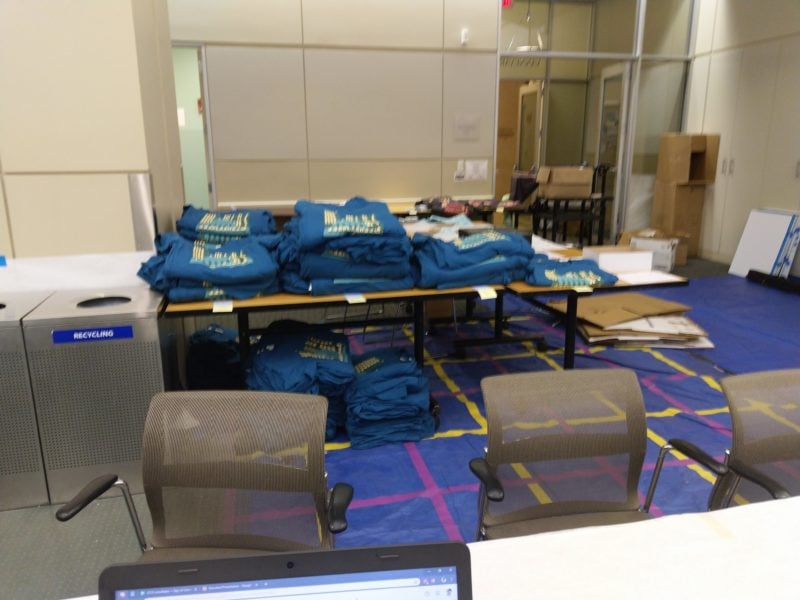
there’s something weird about seeing something you helped design
All throughout campus, other ESP admins put up signs. Lots and lots of signs. Splash has classrooms in about a dozen buildings, so lots of signs, everywhere, were really important to help students and teachers get from classroom to classroom.
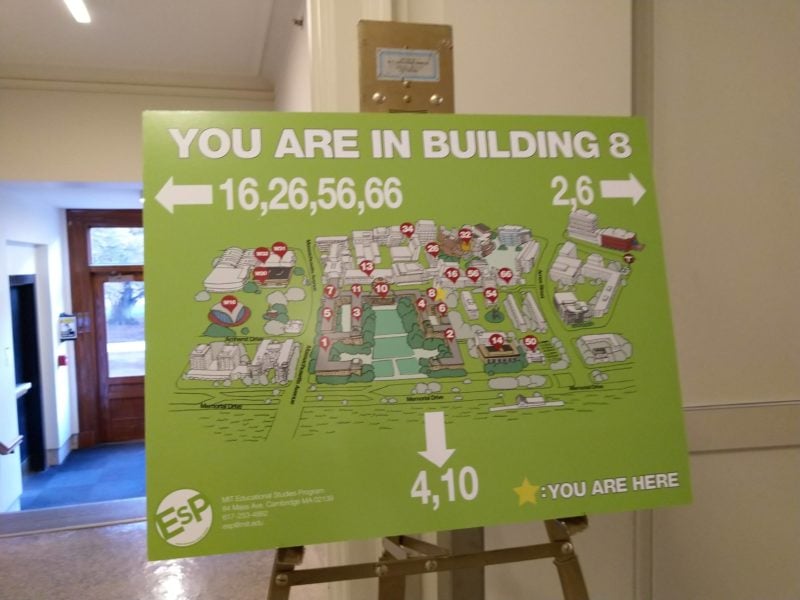
these are new signs apparently
That evening, there was a short admin briefing meeting talking about day-of logistics. After the meeting, I hang out in the Bush Room doing last-minute preparations for my classes. I end up in my room at around eleven, but I was so tense that I couldn’t sleep until half past midnight.
Part 2: Twelve hours of teaching
Class class class class
I woke up 7 AM the next morning, to the sound of a wake-up phone call. I checked in at the Bush Room and grab my nametag and a pronoun sticker. The admin nametags all had cute small blurbs.
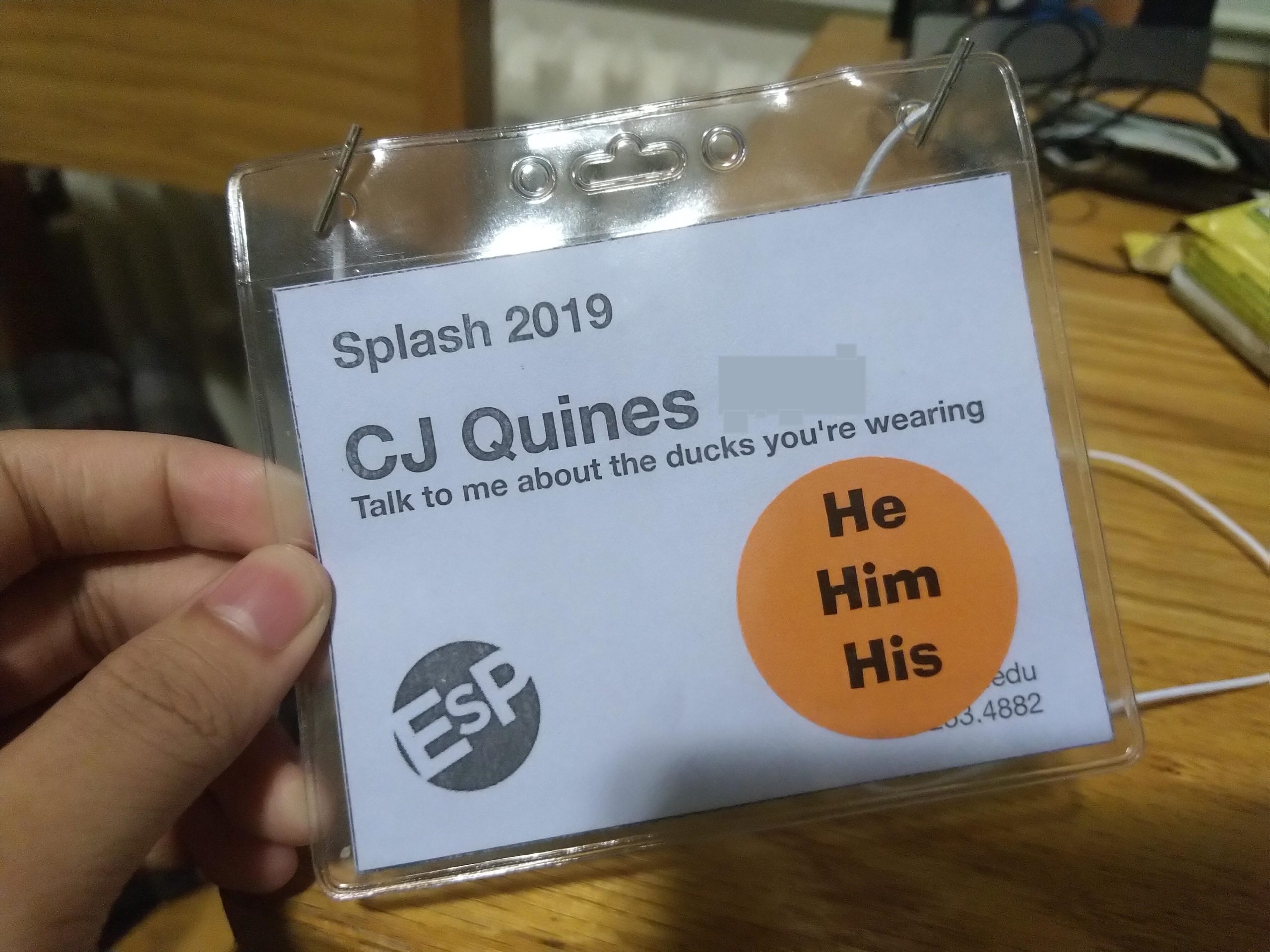
I grab a donut for breakfast.
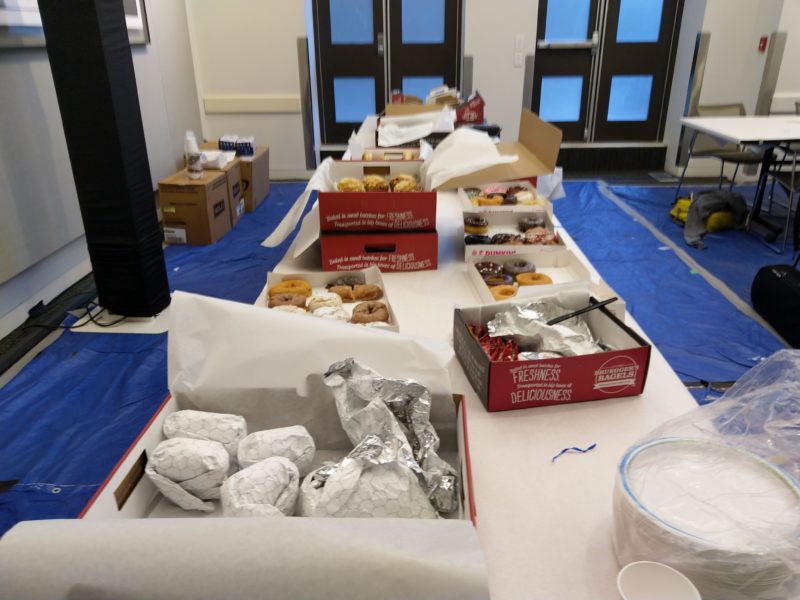
I headed to DuPont to help with checking in students. There was around two dozen or so volunteers, all with red shirts saying “ESP VOLUNTEER”, a bunch of stanchions leading a path to a row of like, six tables, and leading to another row of six tables, along with projected instructions and lots of helpful volunteers. I was helping out at troubleshooting, where we helped students who had incomplete forms and payment issues.
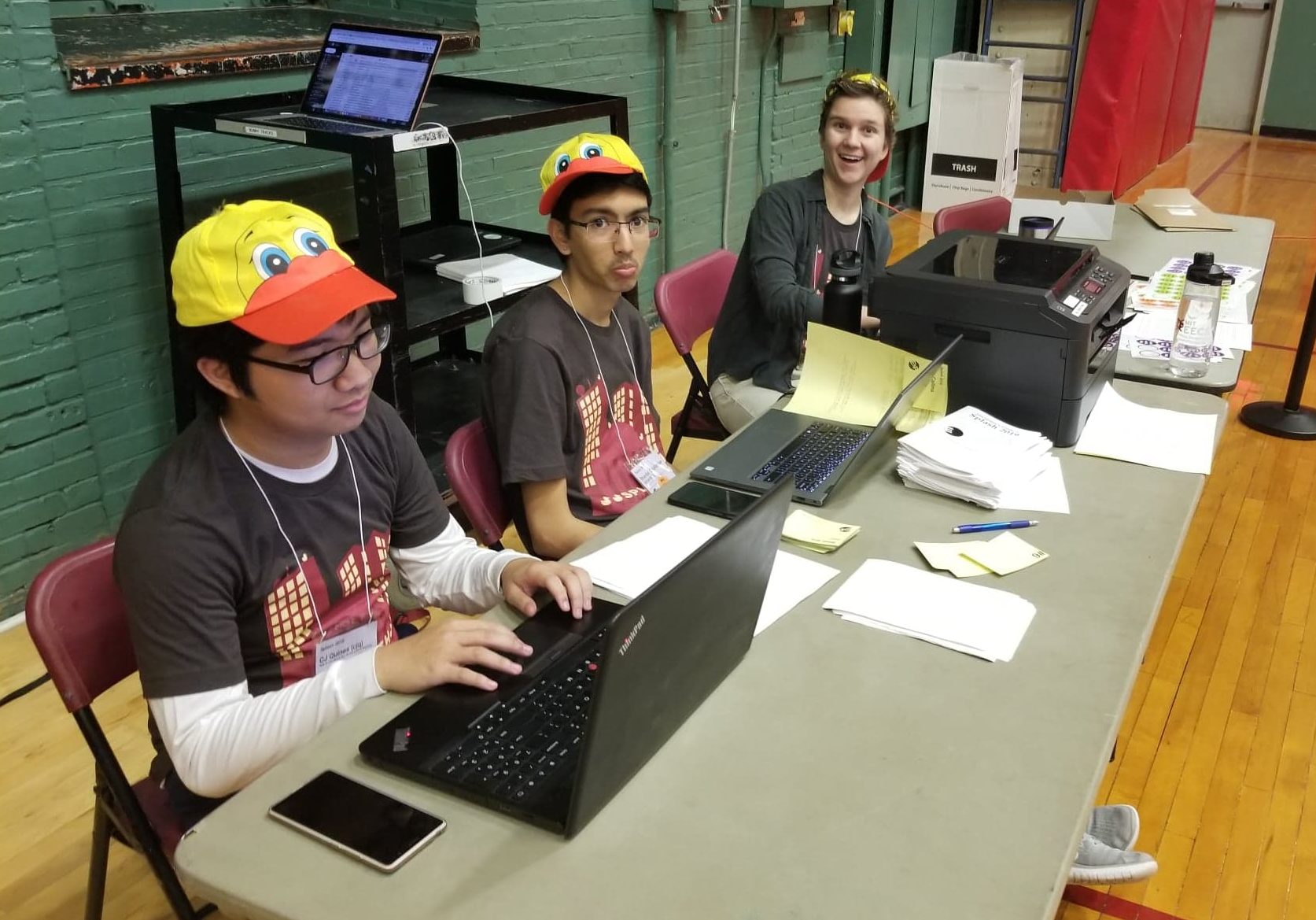
the troubleshooting desk. left to right: me, shardul c. ’22, sarah w. ’21. photo: ahaan r. ’19
After an hour or so, I left morning check-in and headed to the first class I was teaching, which was Introduction to Esperanto. Esperanto is an invented language that’s made to be simple and easy to learn. It was held in this small seminar-style room, and we went over how to construct basic sentences in Esperanto, as well as affixes, which I think are one of the coolest parts of Esperanto.
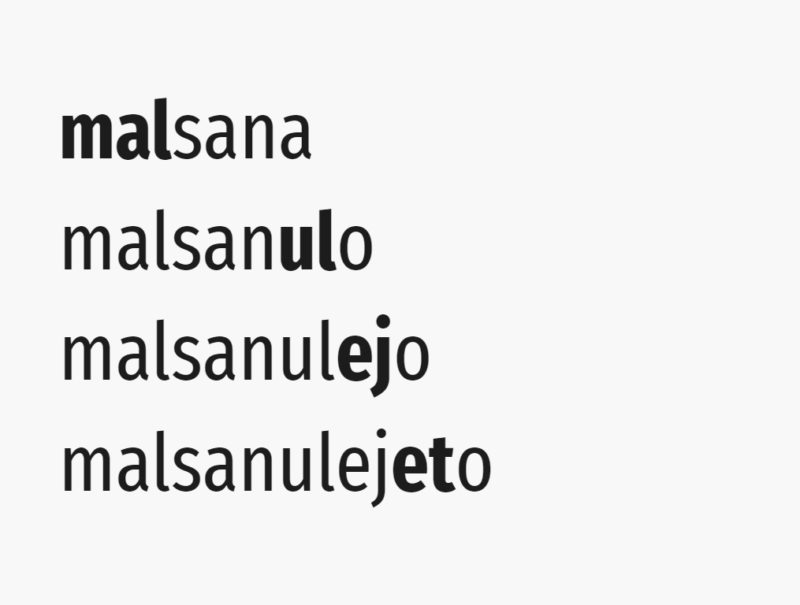
For example, the word malsanulejeto is built up from combining four affixes in the same word:
- The root word, sana, means healthy.
- Adding mal- gives it the opposite meaning, malsana, or sick.
- Adding -ulo turns it to a person, malsanulo, someone who is sick.
- Adding -ej- makes it to a place, malsanulejo, a place for sick people, or a hospital.
- Finally, adding -et- makes it smaller, malsanulejeto, a “small hospital”, like a clinic or infirmary.
This was an interesting class in that my coteacher, Carl S. ’23, didn’t know how to speak Esperanto at all when I asked him to coteach with me. So I guess that’s proof that Esperanto can be learned quickly.
The second class I was coteaching was Flirting 101. The idea was born out of a joke: I’d take a class about flirting if there was one, or something. Grace C. ’23 led the lecture in room 1-190, one of the biggest lecture halls on campus, filled with around a hundred or so people.
If she led the entire lecture, then, why was I coteaching? Well, her lecture had certain parts where volunteers from the audience demonstrated what was being taught. Since it would be awkward to make students who didn’t know each other to demonstrate flirting, us five or so coteachers were audience plants for volunteers. I demonstrated some non-verbal communication with Vincent H. ’23, which included light shoulder pats and a technique called sticky eyes.
People apparently really liked this class for some reason; it was the highest-rated class I cotaught.

observe the overall rating
After that I had lunch with the other teachers in the Bush Room, while reviewing my slides and getting ready for my next class. There was a lot of juice.
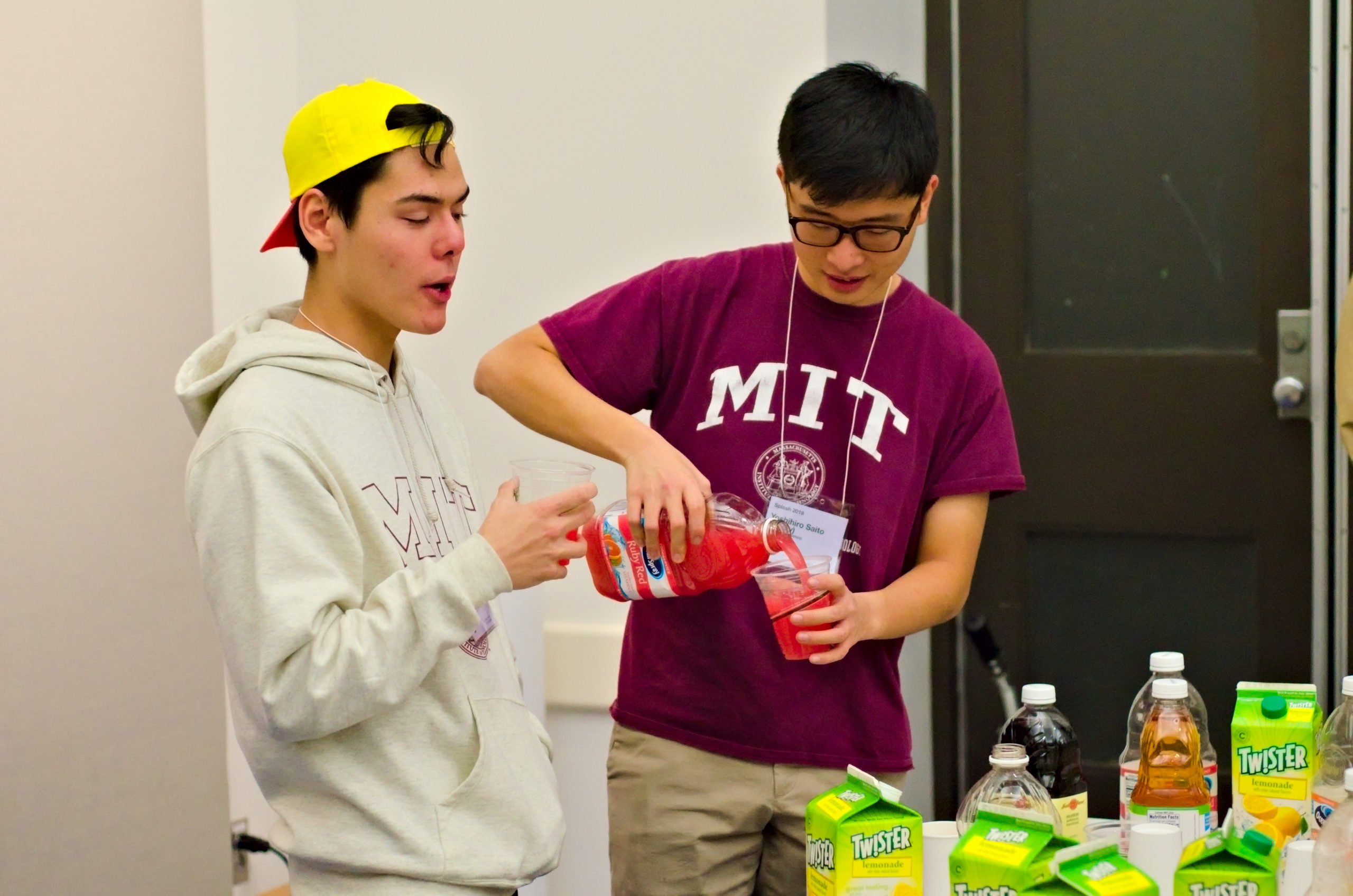
left: marco n. ’23, right: yoshi s. ’22, drinking grapefruit juice. photo: byron x. ’21
I had an hour before my next class, but it didn’t really feel like an hour. Soon enough, I was back in the classroom coteaching my next class, How to Read a Law, with Theo B. ’23.08 whom you might recognize from <a href="https://mitadmissions.org/blogs/entry/guest-post-good-morning-or-good-night/">this guest post</a>
I didn’t really have any idea what we were doing with that class, since I wasn’t really sure what to teach. Theo and I decided to focus on reading statute law, and I only learned what statute law was while preparing for the class, oops. We decided to stick with teaching two tips: taking careful note of the context of a law, and breaking down sentence structure. It turns out that we underplanned and didn’t have enough content, but Theo came to the rescue by dishing out lots of stuff about the government.
My fourth class09 the class after my class after my class after my class, or more briefly, the class class class class that day was, thankfully, not a class I was leading. I was also coteaching it with Theo, and he would be leading the class. We had to go from Building 5 all the way to the Student Center, which was a ten-minute walk.
The class was Improv Workshop, which was, as its name suggests, an improv workshop. Theo led the class with improv games for an hour, teaching basic improv principles like Yes And. I helped demonstrate the games and give prompts. It was a fun, energizing class that gave me a little more energy to power through the rest of my overcommitment.
Help Help Desk desk
I had an hour free after Improv Workshop and before my next class, which I used to help Help Desk desk.10 help (assist) Help Desk (the place where people get help) desk (a verb, to desk) The Help Desk at Lobby 10 was, as the name suggests, a place where people could come to get help. I helped students change classes, printed schedules, gave directions, answered parents’ questions, and checked people in. I found it quite fun!
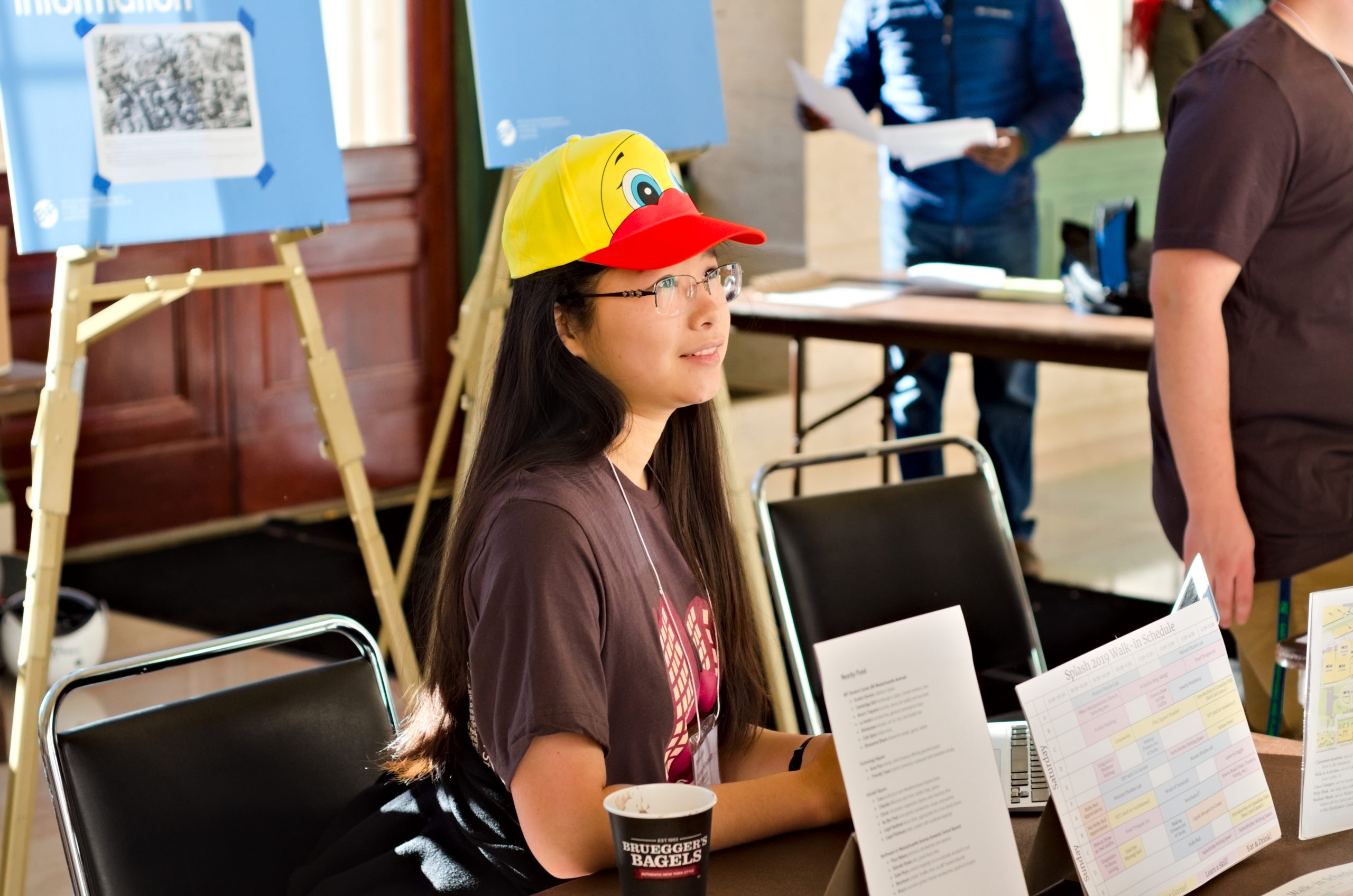
jenna h. ’21, one of the help desk subdirectors. photo: byron x. ’21
My next class was Relating Games, which was probably the least traditional class I cotaught. The Atlantic has a good feature about relating games; basically, we played games designed to build intimacy with each other. This was the class I was scared about the most. My coteacher, Hahn L. ’23, and I were facilitating a room of twenty strangers, and it was only the second time that I was facilitating any kind of event. The first time was when Hahn and I got a bunch of our friends together to practice for this class. We were very new to the whole thing, but Hahn kept reassuring me that it would be fine.
Two hours gave us enough time to play three games: one involving eye contact and shaking hands, one involving sitting in a circle and asking questions, and one where we all sit in a circle and tell the person to our left something we want someone to tell us. I think it went well. Feedback from after the class was positive, and at least one person reported finding a new friend. I was surprised with what people shared they felt after playing; I didn’t expect others to take the class seriously. Then again, the group is self-selected, which may have helped.
After Relating Games, which was probably my most exhausting class, I head back to the Bush Room to eat some dinner. By then, I’ve taught for six hours. I guess I was starting to look tired.
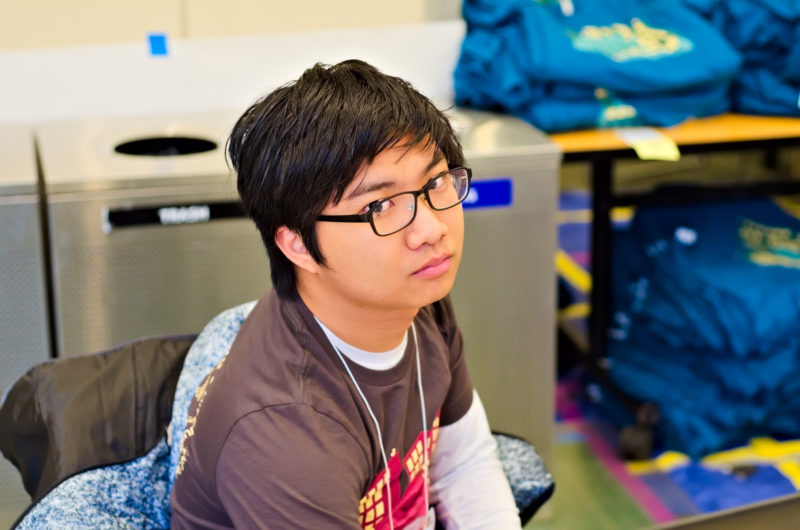
photo: byron x. ’21
I had two more classes that day: two one-hour sections of Estimation Markets, a class I was coteaching with three other people. We played a simulation of a market, where instead of stocks, people bought and sold tokens whose value was the answer to an estimation questions, like “How many ambulances are there in the United States?”
Most of my work for the class was researching good questions, so I didn’t do much in the actual class. It turns out that the main challenge of the class was explaining how markets worked. I don’t think we did this well for the first section, but for the second section we did a demo involving buying and selling pieces of chalk, and I think that helped explain it better.
The class ended at 9 PM, which meant I had spent the last thirteen hours doing things for Splash. Syncopasian, MIT’s Asian a capella group, had a concert that night. I went and cheered for my friends. It was a great concert, probably my favorite one all semester. After that, a group of friends dragged me to Epsilon Theta, an independent living group, to play some board games. I head back to campus a little past midnight, tired from a fun day of teaching.
But somehow, I wasn’t exhausted.
It’s a very silly game
I wake up a little past 9 AM the next morning. My first “class” was actually a walk-in activity from 10 AM to 12 PM, so I had enough time to prepare. A walk-in activity is a different kind of class that takes place in Lobby 13; instead of being a class, we just kind of set up a booth and let people come and go between classes or during breaks.
For example, one of the booths was Ruby Red Appreciation, where people could sample Ocean Spray Ruby Red Grapefruit Juice.11 remember that picture of Marco and Yoshi earlier? yeah, they were drinking Ruby Red. This was directly beside the Not Ruby Red Appreciation booth, where people could sample juices that weren’t Ruby Red. The reason these booths exist is because the status of Ruby Red is highly controversial among ESP admins, with some people liking the juice so much, while others hating it. Personally, I think that everyone who likes the juice is wrong.
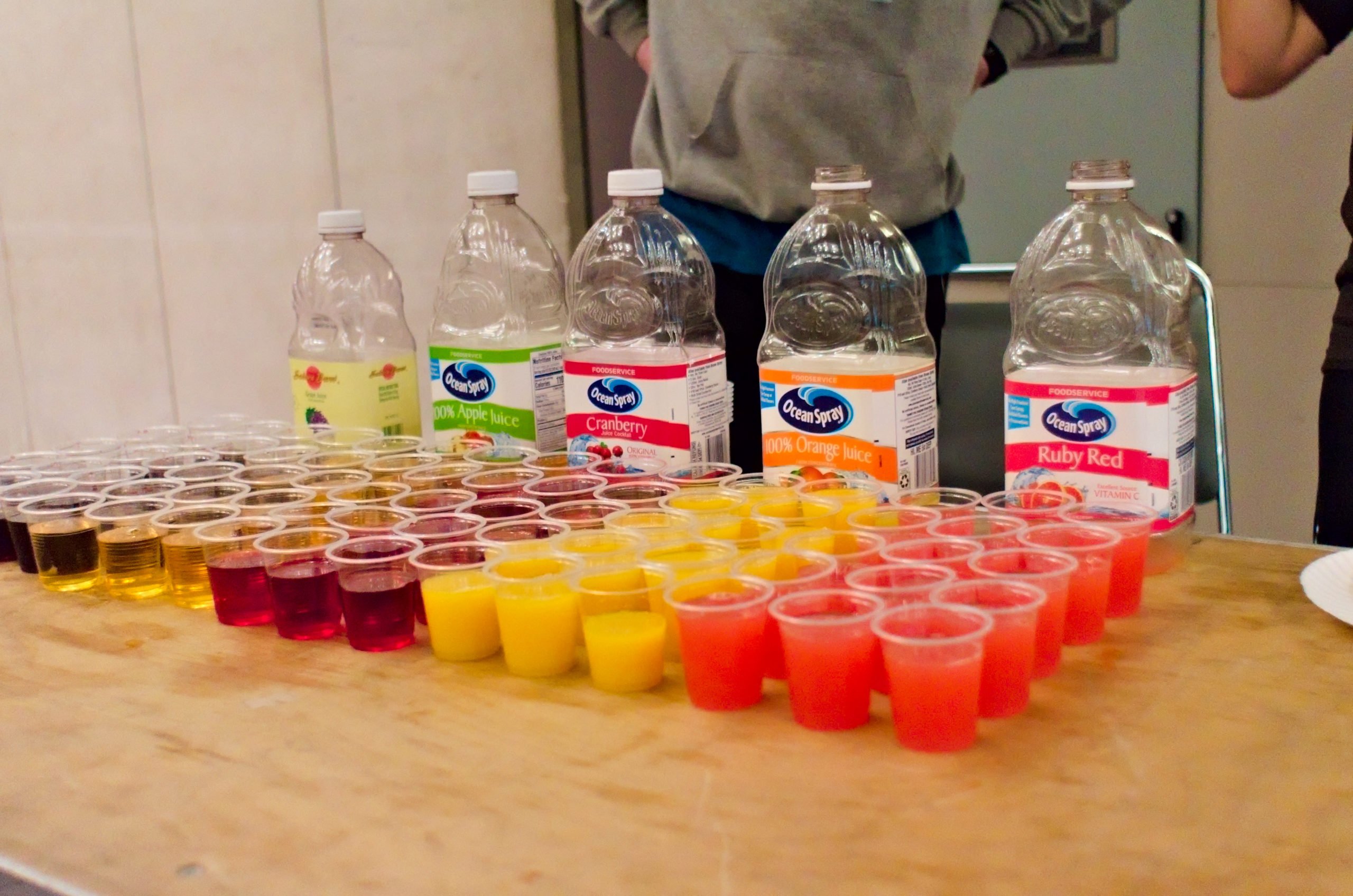
from left to right: grape juice (good), apple juice (good), cranberry juice (good), orange juice (good), ruby red (bad). photo: byron x. ’21
There were a bunch of other booths too, like a booth where people played SET variants, a mutant plushie lab where people stitched parts of stuffed animals together, and a booth for making small, cute, paintings.
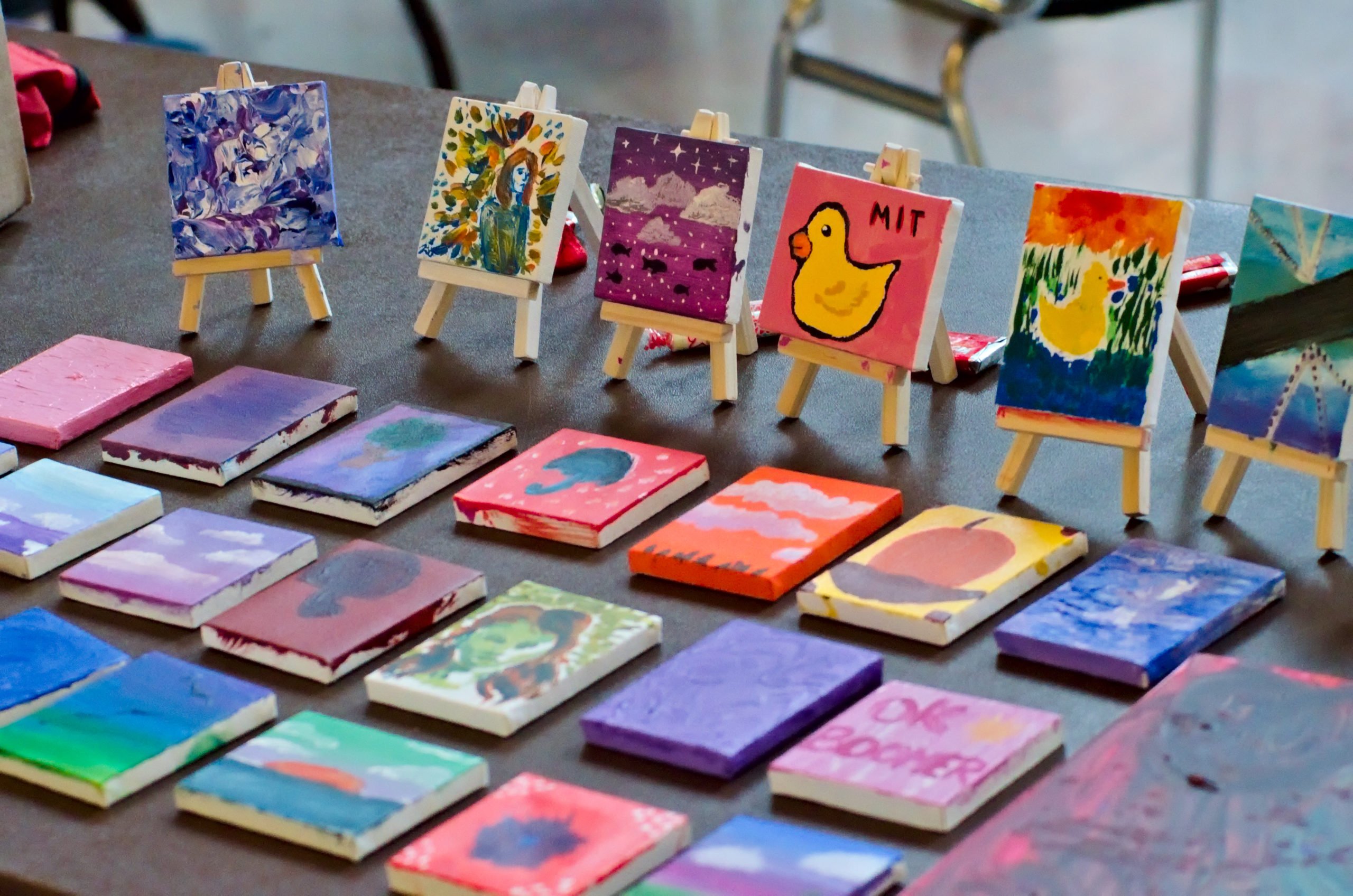
photo: byron x. ’21
Wayne Z. ’23 and I led a walk-in activity called Find the Missing Card, where we got people to play a game called Find the Missing Card. It goes like this: I hand you a shuffled deck of standard cards, except one of the cards is removed. Then I start a stopwatch. You can then look through the deck of cards, and you’re trying to figure out what the missing card is, as fast as possible.
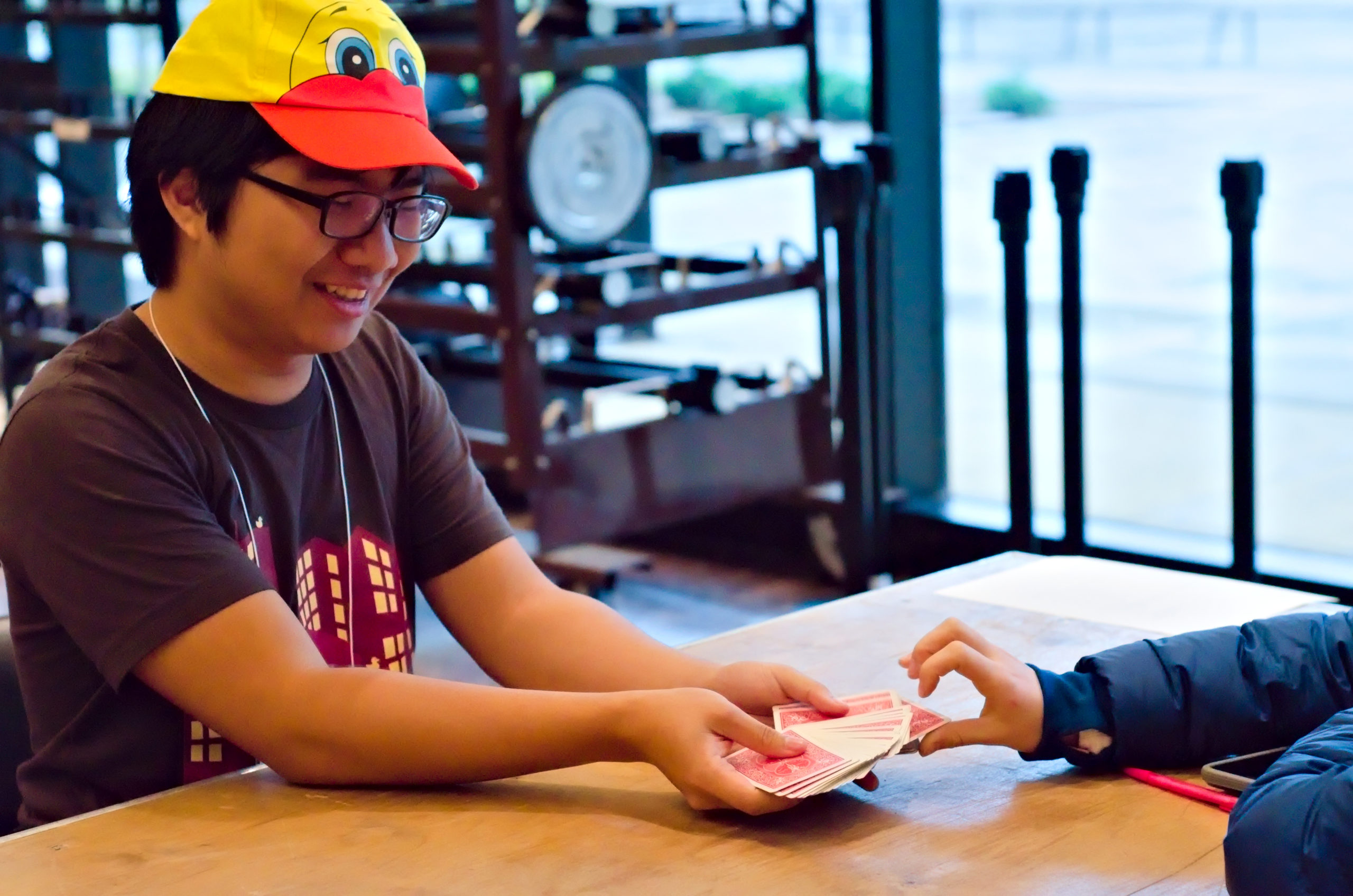
photo: byron x. ’21
If it sounds like a silly game, that’s because it is. But it’s surprisingly fun. I first learned the game in PROMYS. When I introduced it to my floor in East Campus, we played the game for a solid two hours or so. The fastest time I’ve seen, lucky, is 18 seconds; I know someone who can average 30 seconds. The walk-in was surprisingly successful; around six people came to play the game at least once, and of those, three people played it at least four times. Wayne and I secretly used the walk-in as an excuse to explain to people what algorithms were.
After that, I had lunch. On the Bush Room chalkboard, I spot a bunch of ducks that people drew.
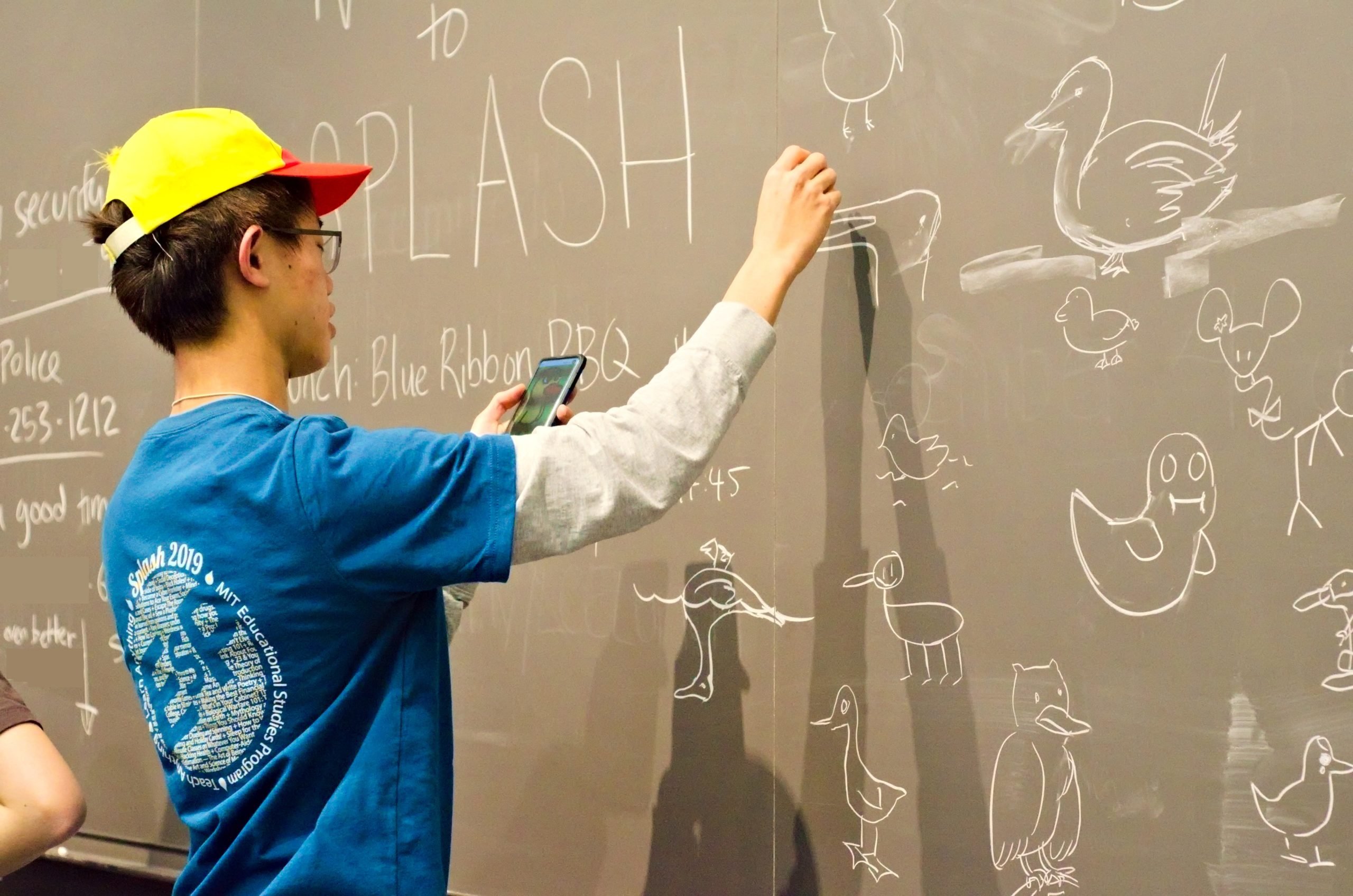
vincent b. ’23 draws a duck. photo: byron x. ’21
I helped Help Desk desk for a few minutes, and then Carl and I taught another section of Introduction to Esperanto. I think this section went a little better than the first section, but otherwise we didn’t change much. After that, I helped Help Desk desk for around an hour and a half, before I went to my final class.
My last class was also with Wayne. We taught a class called 694201 is a prime, which was about the Miller-Rabin primality test. The ultimate goal was to test whether 694201 is a prime using a four-function calculator, using roughly this article as an outline. This meant explaining what we were going to do, proving that it would work, and then actually executing it.
This was also the class I prepared for the least. Wayne and I were thinking that because we had an entire article to base off of, then we didn’t need to prepare that much. It turns out that this was extremely wrong. We grossly underestimated the amount of time we needed to explain the Miller-Rabin primality test, because there was a lot of background that we needed to go over, and we didn’t have enough time to do the actual test at the end.
Oops. At least class evaluations were somewhat positive; the people who answered the end-of-class survey reported that they understood what Miller-Rabin was and why it works.
Part 3: The why game
Free candy
The class ended at 5 PM, after which I participated in cleanup. Although the last class period of the day was 5 PM to 6 PM, cleanup and takedown start a bit earlier than that to leave enough time for cleaning everything up.
While helping clean up walk-ins, Wayne messaged me, asking if I could bring him Ruby Red. It turns out that he needed some Ruby Red for the last class he was co-teaching, Introduction to Programming Languages, which was a class about what programming languages are named after, and not the actual programming languages. Like Java, the island in Indonesia, or python, the snake, or ruby, the gemstone. I went in their classroom carrying Ruby Red and some cups, and then headed back to help with cleanup again.
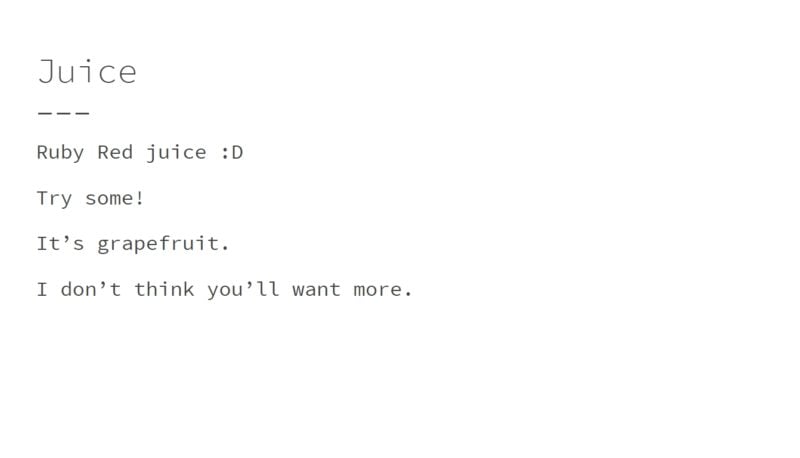
taken from their slides; this one is about ruby
I helped take down signs, and carried a cart from the Bush Room to the ESP office. Then I helped clean up Help Desk. It turned out that Help Desk was offering free candy to people if they provide feedback about Splash.
I stayed for a couple minutes saying “Free candy!” which helped get students to provide feedback. The feedback ranged from everything to favorite classes that students had, to comments about how to improve signs and food, complaints about the weather, comments about accessibility, everything.
At 7 PM, Splash had a teacher appreciation dinner. By then, most of the cleanup was done. I went to Lobdell and ate dinner, sitting with some other friends who taught for Splash. Jenny G. ’22 and Andrew, the two Splash directors, gave short speeches thanking the teachers, and some student feedback was also read.
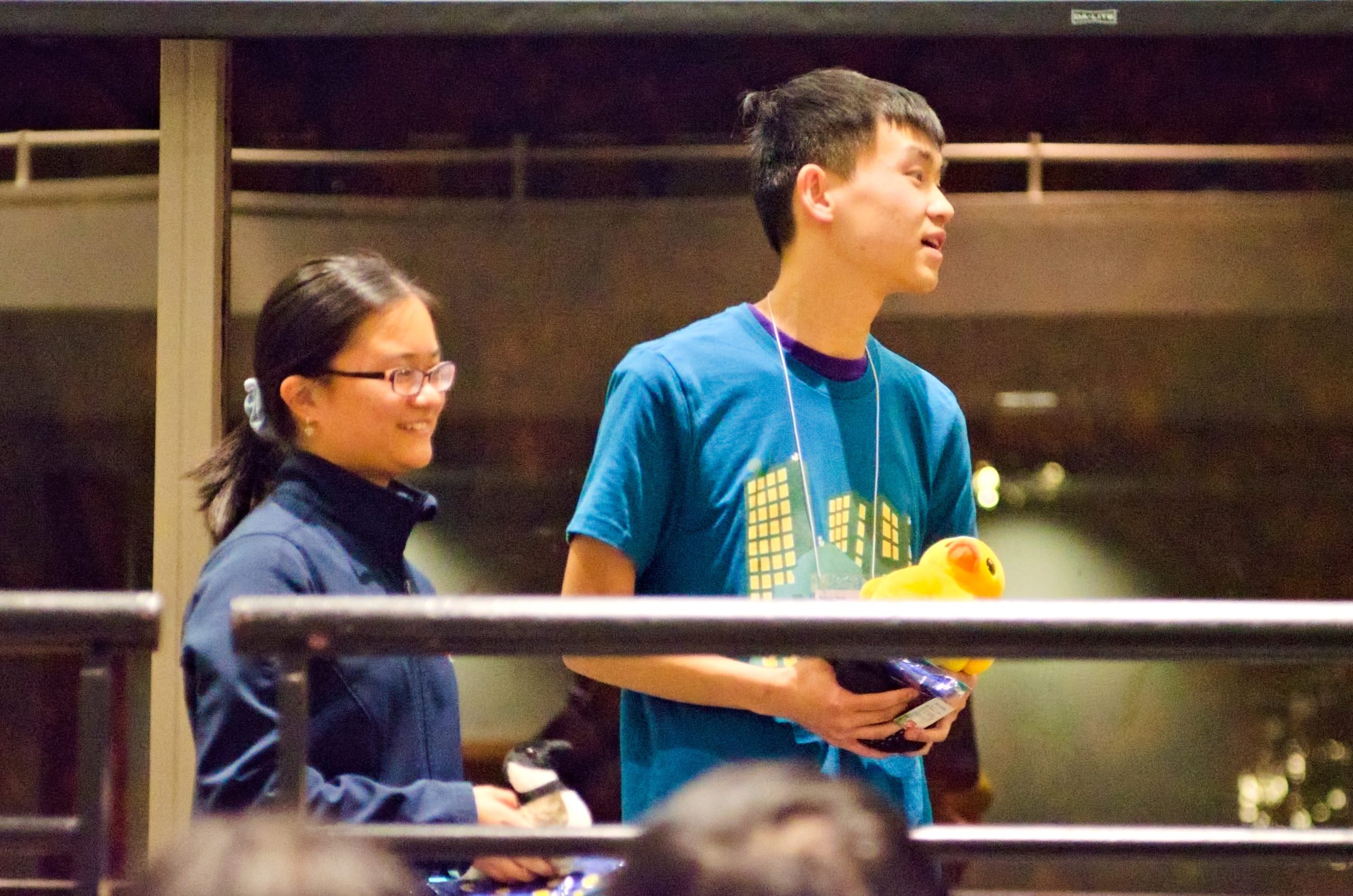
left: jenny, right: andrew. photo: byron x. ’21
The dinner lasted for about two hours, ending at roughly 9 PM, and we brought the leftovers upstairs for a wrapup discussion.
On grasping scale
The wrapup discussion was a place for ESP admins to talk about what happened during Splash. We were all pretty exhausted from two days of Splash, including my roommate Jeffery, but we had the discussion anyway.
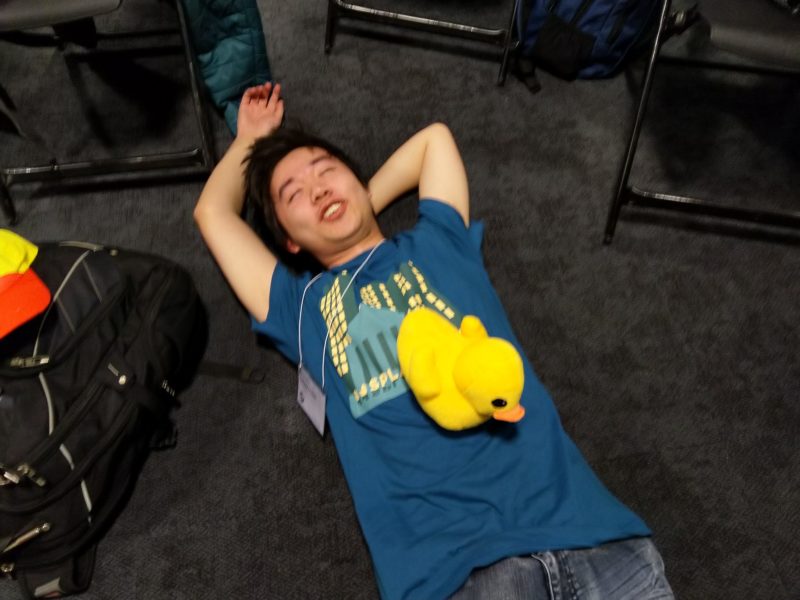 We sat in a big circle of around thirty people, while Andrew and Jenny led the discussion. It was interesting to see how ESP conducted its discussions, since this was the first ESP discussion I went to.
We sat in a big circle of around thirty people, while Andrew and Jenny led the discussion. It was interesting to see how ESP conducted its discussions, since this was the first ESP discussion I went to.
What struck me the most during the wrapup was the scale involved in running a program like Splash. There were so many moving parts to Splash, all the way from teacher recruitment to student food to security, not all of which I’ve seen fully. Remember how earlier, I talked about subdirectorships? It turns out Splash had 21 different subdirectorships led by 31 people. There were maybe 50 or so admins who ran the program, and who knows how many dozens of volunteers there were.
It was mind-boggling to think that I was only one of these people. Later on, I talked to my other frosh friends who did have subdirectorships, like Laura C. ’23 who helped with Class Supplies, or Zawad C. ’23 who helped with Class Changes, among others. The general consensus was that it really wasn’t that huge of a time commitment, around two to six hours or so before Splash, and several hours on the day-of, which was around how much time I spent for Splash too. They talked about how it was fun to take responsibility of part of the program, and how it was fulfilling to be a part of something big like Splash.
It awes me, to this day, how Splash managed to run at all. I felt like I only got to saw a small part, a tiny portion of how the whole program worked, and I still don’t get the big picture of how it happened. From my perspective, all I saw was a program where hundreds of teachers and thousands of students learn from each other over a weekend. And when I think about it, everything else felt like magic. I don’t know how it happened, but it did.
And all I can write about is what I experienced helping out, which isn’t enough to capture the dozens and dozens of experiences behind making Splash happen. And this blog post is a very incomplete picture of what it’s like. And I want to know what it’s like.
I felt like so many hours of people doing work for Splash, so many weeks of planning, and so many years of ESP’s previous experiences were all hidden from me. It felt amazing, thinking about that.
And it feels amazing, thinking about the part that I gave, the part of Splash that I contributed to. That no matter how small that part was, I still had a part.
The why game
Since Splash ended, there have been elections to decide officerships for next semester, as well as elections to decide who’ll direct ESP’s programs in the spring. After much consideration, I decided not to nominate myself for any of the officerships or directorships.
I still don’t know if I want to take a subdirectorship for any of the spring programs. I’m pretty sure I want to keep going to ESP’s worksessions every week, but ever since Splash ended, I’m really considering taking on a role for one of ESP’s future programs.
I remember one of the things that Andrew asked me, once, towards the end of one of ESP’s worksessions.
What do you get out of doing things for ESP? It’s fun. I enjoy it.
Would you enjoy it more than doing something else? I don’t know. But I do enjoy it a lot.
Well, I think it’s important to know why you want to do things.
He said something about how I shouldn’t just take on involvement just for the sake of being involved. And I guess he’s right. I really should know why I want to do things, in the same aggressive way that three-year-old me asked why. You know, that game where you go:
Why does it rain? Because the clouds have water in them.
Why do the clouds have water in them? Because the Earth’s water evaporates, rising into the sky, becoming clouds.
Why does the water evaporate? Because the sun heats it up, making it hot.
And in the same way,
Why do you do things for ESP? It’s fun. I enjoy it.
Why do you find it fun? It makes me feel fulfilled.
Why does it make you feel fulfilled? It feels nice to accomplish something, to be a part of something bigger than yourself.
Why do you want to be a part of something bigger than yourself? Well, I—
I don’t know. I don’t know why. I don’t know what I want to do. I don’t know what I enjoy, or what makes me feel fulfilled, not yet.
But if I just keep doing what I’m doing, I’ll figure things out, right?
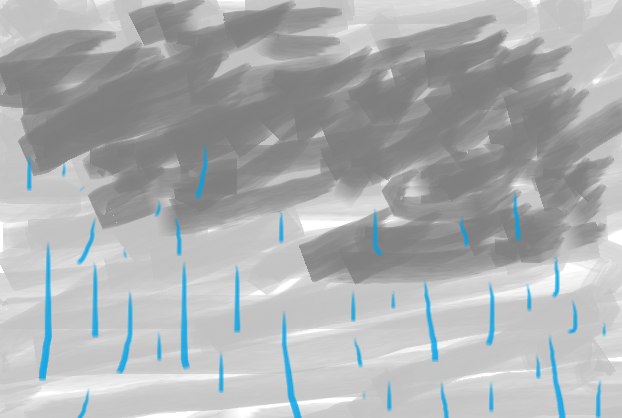
why does it rain?
After the wrapup discussion ended, I walked from the Student Center to East Campus. I was exhausted, a happy kind of exhausted, after two days of running on full power. It was a quiet Sunday evening, and the rain had stopped. The Infinite Corridor was deserted and the classrooms in Building 56 were all empty, a stark contrast from what it was just a few hours ago.
By the time I arrive in East Campus, it was a little past 11 PM. In the courtyard, a large recession in the sand caught the rainwater from earlier, forming a large puddle. The wind blew over the puddle, making ripples in the water.
I didn’t have to think about preparing for classes any more. I didn’t have any more classes to teach. I wasn’t going to be surrounded with other people the next day. The thing that I’ve been waiting for to happen, for two months, came and went. I felt satisfied. So, so satisfied. But I also felt like a tiny part of me had been taken out.
All of a sudden, Splash was over.
- so why is this post so late? I was busy, okay. back to text ↑
- who is, in fact, from Harvard back to text ↑
- people who make ESP stuff happen back to text ↑
- MIT’s square dancing club back to text ↑
- in retrospect, I’m not sure if this made me do less work for Splash, as I explain in the section On grasping scale back to text ↑
- maybe except for 3.7 Seconds for each Pokémon, a class my roommate Jeffery L. ’23 taught, which took several nights of pasting Pokémon sprites into 809 different slides, one for each Pokémon back to text ↑
- problem sets; homework back to text ↑
- whom you might recognize from this guest post back to text ↑
- the class after my class after my class after my class, or more briefly, the class class class class back to text ↑
- help (assist) Help Desk (the place where people get help) desk (a verb, to desk) back to text ↑
- remember that picture of Marco and Yoshi earlier? yeah, they were drinking Ruby Red. back to text ↑